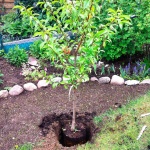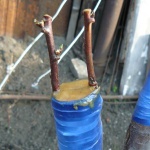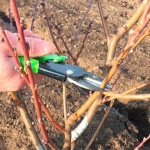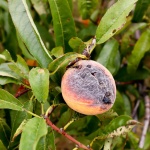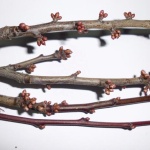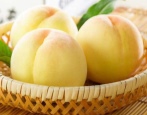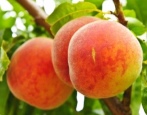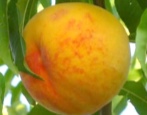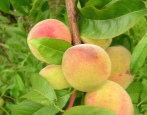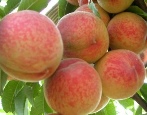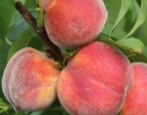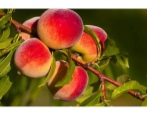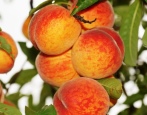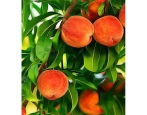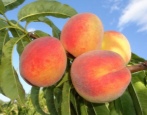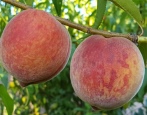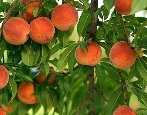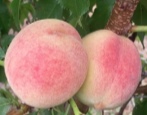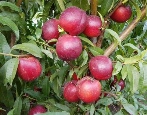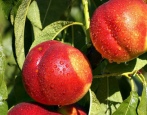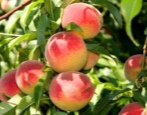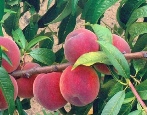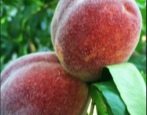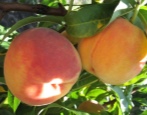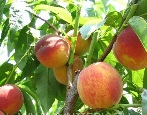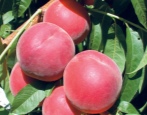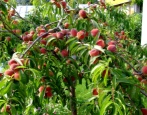
- Authors: A.N. Ryabova, I.N. Ryabov (Nikitsky Botanical Garden)
- Appeared when crossing: Elberta x Salvay
- Year of approval: 2014
- Growth type: medium-sized
- Ripening period: average
- Self-fertility: self-fertile
- Appointment: dining room
- Yield: high
- Early maturity: in the 4th year after planting
- Growing regions: North Caucasian
Peach is an atypical crop for growing in vegetable gardens. Many gardeners are sure that it will be impossible to grow any kind of peach due to the fact that the plant is too thermophilic. Therefore, there are many prejudices in this regard. But the selection does not stand still, and a huge number of breeders from year to year are trying to expand the range of varieties that can be comfortably grown in any regions of Russia without losing yield. Peach Golden Moscow belongs to just such varieties.
Breeding history
The variety was bred in the Nikitsky Botanical Garden. The authors-breeders were I. N. Ryabov and A. N. Ryabova. Two types of peaches were chosen as a parental pair: Elberta and Salvey. The purpose of the culture is dining. The plant was approved for use in 2014.
Peach Golden Moscow grows best in the North Caucasus region. According to the originator, it has the highest yields. But with proper care and good weather conditions, the crop is grown in other regions. And also the fruit is grown on an industrial scale for subsequent sale.
Description of the variety
The tree belongs to the group of medium-sized, but at the same time it grows and develops quite quickly. By the third year of life, the height of the trunk reaches 1.5 m.And the total height of an adult tree is 3.5 m.
The crown is very dense, spherical in shape. Opinions differ about its formation. Some gardeners strongly recommend pruning the branches (especially in the early years) and then removing only the dry ones. Others do not touch the crown at all and give it the opportunity to grow the way it wants. Lateral and skeletal branches do not depart from the main trunk in a chaotic manner: they grow in a structured way and resemble a ball from afar.
Leaves are medium in size, slightly elongated and pointed. This shape is also called lanceolate. The leaves are green, matte. The leaf plates are very smooth, the section can be clearly traced only from the back surface.
The flowers of the peach are solitary. In shape, they resemble a rose, but slightly oval, and therefore belong to the rosy type. The shade of the buds is pink.
The positive characteristics of gardeners include high yields and regular annual fruiting. Peaches also have excellent taste. The tree is resistant to frost, only young seedlings should be sheltered from frost in the first years. The presentation of the fruit is wonderful. Peaches have good transportability and can be transported over long distances.
Among the minuses, it is noted that if the crop is not cared for during the season, then yield indicators may fall. The variety can be attacked by pests or fungal diseases.
Fruit characteristics
The fruits of Golden Moscow are quite weighty. On average, the weight of the fruit is 130-180 g. With proper care and good weather conditions, the indicators can increase to 200-230 g. The peach is round in shape. The color of the fruit is bright yellow, with a slight carmine blush. The rind is of medium thickness, slightly firm. It separates well from the pulp. Puffiness on the skin is present, it is medium and feels more like velvet.
The pulp of ripe fruits is very juicy, fibrous and dense. It is golden yellow in color, and the area around the seed has a raspberry tint.The stone is large, it is separated from the pulp without much effort.
The purpose of the fruits is universal, therefore, jams, juices, mashed potatoes are prepared from peaches. They are also consumed fresh.
Taste qualities
The tasting score of Golden Moscow peaches is very high and equals 4.5 points. Sugars are 11.76%, and acids are 0.48%. At the same time, the taste is quite sweet, in the rare case with a slight sour aftertaste. If there is too much sourness, then, most likely, the fruit is simply not ripe.
Ripening and fruiting
After planting the seedling in the ground, fruiting will begin at 4 years. In terms of ripening, the culture belongs to the middle groups. In the southern regions, flowering occurs in April, the culture blooms until the end of May. And in colder climates, everything shifts by 2-3 weeks. Fruiting falls on the 2-3 decade of August.
Yield
There is a high yield. But it is typical only for an adult tree. In the first year of fruiting, the crop can only bear 5-7 kg of fruit, the next season the yield will increase to 10 kg. An adult tree can form about 40-50 kg of fruit per season. On an industrial scale, the indicators are 140-216 centners per hectare.
But all indicators can vary depending on the place of cultivation and climate. Some experienced gardeners recommend normalizing the number of fruits on a fruiting branch. This is necessary in order for the fruit to grow large. If this procedure is not carried out, then there will be more fruits, but they will begin to shrink. And every year the downward trend will only grow.
Self-fertility and the need for pollinators
The culture is completely self-fertile, so additional pollination is not needed for the buds.
Growing and care
There are no special rules for caring for Golden Moscow peaches. Basically, they comply with all the necessary agrotechnical measures.
The time for planting seedlings directly depends on the region. In the southern regions of the country, landing can be carried out both in autumn and spring. In the northern territories - only in spring.
The culture is very fond of the sun, it needs an abundance of sunny color for comfortable development and fruiting. Therefore, gardeners are advised to choose a sunny place that is not shaded by anything, and is also blown by the winds, but there are no abundant drafts.
To plant a seedling, you need to prepare a site. The procedure is carried out in advance, 2-3 weeks in advance, so that the earth does not start to collapse too much. The hole should correspond to the 100x70 cm pattern, where the first value is the depth. At the bottom of the hole, it is worth making drainage from broken bricks or pebbles so that water does not accumulate.
In the morning before planting, you can pour humus on the bottom of the hole, and then sprinkle it with earth a little. Then the seedling is carefully lowered, the roots are distributed so that when covered with earth, they do not break. The soil around the trunk must be tamped down and pressed a little harder against the trunk. After that, everything is spilled abundantly with water. Straw or sawdust mulch can be placed around the trunk.
After that, all that remains is to properly care for the tree. Basically, the care is as follows.
- Watering. It should be regular and abundant. The soil must be moistened to a depth of 60-70 cm, and the volume of water must be at least 30-40 liters.
- During the season, it is worth making up to 4-5 dressings. From organics, chicken manure, mullein, compost, peat and green manure are most often used. As well as mineral preparations: nitroammofosku, potassium (sulfate and monophosphate), ammonium nitrate, phosphorus and nitrogen.
- Pruning is done in the fall and spring. In the spring, dry branches are cut off and a crown is formed, and in the fall, diseased or broken branches are removed. All cuts are made with a sharp pruner or saw, and the cut is processed with garden varnish to avoid infection.
